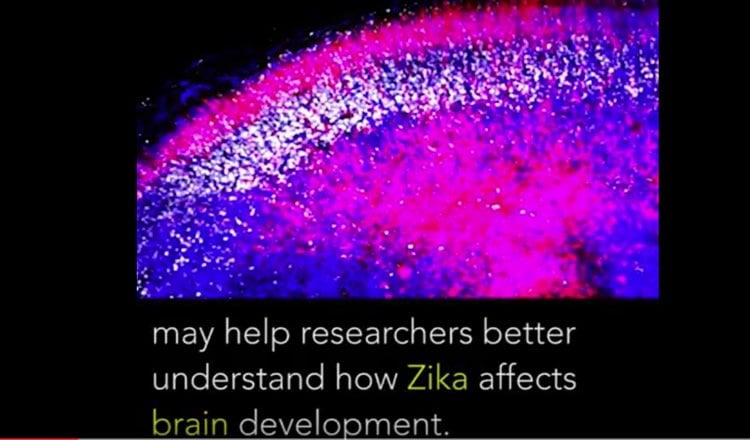Summary: According to researcher, in some genetic cases of microcephaly neural stem cells fail to divide.
Source: Columbia University School of Medicine.
Uncovering how genetic defects cause microcephaly may help Zika researchers.
In a very severe, genetic form of microcephaly, stem cells in the brain fail to divide, according to a new Columbia University Medical Center study that may provide important clues to understanding how the Zika virus affects the developing brain.
The study was published August 24 in Nature Communications.
Due to the Zika virus, the world is suffering from its first known epidemic of microcephaly, a devastating brain developmental condition that substantially reduces the number of neurons in the brain, along with brain size and function at birth.
Mutations in a number of human genes have been implicated in causing the relatively rare occurrence of this disease. Mutations in one such gene – NDE1 (referred to as “nood-E”) – cause a particularly severe form of microcephaly. The Columbia researchers — David Doobin, an MD/PhD student, Richard Vallee, PhD, professor of pathology and cell biology, and others in Dr. Vallee’s lab — reasoned that investigating NDE1’s role in microcephaly should provide important clues to the causes of microcephaly in general.

In the study, the researchers found that interfering with NDE1 expression severely inhibited the proliferation of stem cells in the developing rat brain. These stem cells, known as radial glial progenitors (RGPs), undergo rapid repeated divisions over the weeks-to-months-long process of brain development.
Other genes that cause microcephaly are known to impair RGP proliferation, usually by interrupting the cells when they are in the midst of dividing.
The new study found that NDE1 defects can stop RGPs before division even begins at three distinct arrest points. The net result is a complete failure of these cells to divide, explaining the severity of the NDE1-associated microcephaly.
In a very severe, genetic form of microcephaly, stem cells in the brain fail to divide, according to a new study that may provide important clues to understanding how the Zika virus affects the developing brain.
Numerous labs are investigating the effects of Zika on the developing brain, and some studies already suggest that the virus targets RGP cells in the developing brain. Dr. Vallee’s lab, along with that of Vincent Racaniello, PhD and Amy Rosenfield, PhD, in Columbia’s Department of Microbiology, plan to test for similarities in the damage to neuronal stem cells caused by Zika virus vs. NDE1 mutations.
Funding: The research was supported by the NIH (R01 HD40182, F30NS095577) and an American Heart Association/American Stroke Association postdoctoral fellowship (15POST25080068).
The authors declare no conflicts of interest.
Source: Lucky Tran – Columbia University School of Medicine
Image Source: This NeuroscienceNews.com image is adapted from the Columbia Medicine video.
Video Source: The video is credited to Columbia Medicine.
Original Research: Full open access research for “Severe NDE1-mediated microcephaly results from neural progenitor cell cycle arrests at multiple specific stages” by David J. Doobin, Shahrnaz Kemal, Tiago J. Dantas and Richard B. Vallee in Nature Communications. Published online August 24 2016 doi:10.1038/ncomms12551
[cbtabs][cbtab title=”MLA”]Columbia University School of Medicine. “Stem Cells Fail to Launch in Some Genetic Cases of Microcephaly.” NeuroscienceNews. NeuroscienceNews, 24 August 2016.
<https://neurosciencenews.com/stem-cell-microcephaly-genetics-4899/>.[/cbtab][cbtab title=”APA”]Columbia University School of Medicine. (2016, August 24). Stem Cells Fail to Launch in Some Genetic Cases of Microcephaly. NeuroscienceNews. Retrieved August 24, 2016 from https://neurosciencenews.com/stem-cell-microcephaly-genetics-4899/[/cbtab][cbtab title=”Chicago”]Columbia University School of Medicine. “Stem Cells Fail to Launch in Some Genetic Cases of Microcephaly.” https://neurosciencenews.com/stem-cell-microcephaly-genetics-4899/ (accessed August 24, 2016).[/cbtab][/cbtabs]
Abstract
Severe NDE1-mediated microcephaly results from neural progenitor cell cycle arrests at multiple specific stages
Microcephaly is a cortical malformation disorder characterized by an abnormally small brain. Recent studies have revealed severe cases of microcephaly resulting from human mutations in the NDE1 gene, which is involved in the regulation of cytoplasmic dynein. Here using in utero electroporation of NDE1 short hairpin RNA (shRNA) in embryonic rat brains, we observe cell cycle arrest of proliferating neural progenitors at three distinct stages: during apical interkinetic nuclear migration, at the G2-to-M transition and in regulation of primary cilia at the G1-to-S transition. RNAi against the NDE1 paralogue NDEL1 has no such effects. However, NDEL1 overexpression can functionally compensate for NDE1, except at the G2-to-M transition, revealing a unique NDE1 role. In contrast, NDE1 and NDEL1 RNAi have comparable effects on postmitotic neuronal migration. These results reveal that the severity of NDE1-associated microcephaly results not from defects in mitosis, but rather the inability of neural progenitors to ever reach this stage.
“Severe NDE1-mediated microcephaly results from neural progenitor cell cycle arrests at multiple specific stages” by David J. Doobin, Shahrnaz Kemal, Tiago J. Dantas and Richard B. Vallee in Nature Communications. Published online August 24 2016 doi:10.1038/ncomms12551






